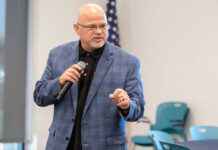Last month the Pinal County Board of Supervisors completed its multi-month review and modification of the draft Comprehensive Land Use Plan.
The road that led to those six board sessions (complete with a public hearing each time as a part of the process) took over two and a half years. By the time the final draft document returns to the board for final adoption (hopefully by the end of this calendar year), after a final review by the Planning Commission as required by state law, the complete journey will have consumed nearly three years, hundreds of public meetings and countless hours of smaller group meetings with various stakeholder representatives. Much of the general public and residents’ input came in the earlier phases, although it was primarily the development community’s voices being heard in the concluding stages.
One of the more contentious elements in the draft Comprehensive Plan concerned water resources: “Issues relevant to water use and available supplies for future growth in the County … [and] sections describing practices for managing future water supplies with goals and policies relevant to water resources.” (Draft Comp Plan, Chapter 7, page 253). As with so many other parts of the draft plan, the water element evolved during the long public process; however, the one point of contention continuously raised by the development community was language suggesting that the county “Explore making policy that will require a demonstration of physical availability of water supplies prior to approving an application for zoning or rezoning ….” (Policy 7.2.6.1, page 263)
After a lengthy debate on Wednesday, Sept. 2, on Chapter 7 – a discussion that included testimony from the public (all but two of whom specifically represented developers or developer interests) – the board voted to delete all of the draft language addressing the water element and let stand the water element language in the current Comprehensive Plan (created in 2001). The vote was not unanimous.
I, and many of those in our county who have been active in debating and recommending water resource policies to local, state and federal authorities over the last 20-30 years, felt that there was a great deal of merit in having the policy proposal (7.2.6.1) in our Comprehensive Plan. I think it entirely appropriate and prudent that our county should acknowledge the connection between water resources (particularly groundwater supplies) and development activities … doing so is long overdue. And inasmuch as the Pinal Active Management Area, in particular, has limited access to CAP water and other so-called renewable (non-groundwater) supplies, I felt especially supportive of the proposed concept.
The County’s Planning Commission has been vocal during the past five or more years in expressing its keen interest in having developers tell them about their plans for water supplies. This is especially true when developments are proposed in areas far from either known water providers or in close proximity to foothills where current residents have to haul water. For the most part, the response was either “we have a ‘will serve’ letter from a local water provider saying they’ll provide our water” or “issues of water supplies and Certificates of Assured Water Supply are the responsibility of the Arizona Department of Water Resources and not due to be addressed until time of final plat and building permit.”
During the course of the debate during the board meeting on Sept. 2, there were several arguments advanced by Supervisor Martyn and the development community’s representatives (as embodied in presentations from the Pinal Partnership and other developer interests such as the Arizona State Land Department, El Dorado Holdings, Walton International, etc.).
Argument A was that the county has no authority to ask for proof of groundwater and/or other water sources since that’s the responsibility of the state, – and it’s not legally required until time of final plat and issuance of building permit.
Argument B assured us all that there are other sources of water available to future generations and their residential developments. The logic seemed to be that there will be new “buckets” of water when we need them, and technologies like desalinization will be the answer. This despite the fact that this technology’s been around since the 1970s and uses so much power to produce a gallon of potable water that the economics still don’t pencil out.
Argument C advocated a continued delay of any consideration of the issues and urged the county to embark on more discussions, studies and meetings.
My response to those arguments was and still is: in a time when this county already has hundreds of thousands of lots already well along the path toward final plats (if not already arrived) and building permits, and the groundwater supplies in our county are finite, it’s only prudent public policy for county planners and their citizen commissioners to have a sense of reassurance about the prospects for water supplies to support sustainable growth and development.
Certainly desalinization is one tool for augmenting current water supplies, but the energy costs are mostly prohibitive (which is why we don’t have a desal plant on every corner), and the nagging question of how to dispose of the toxic brine that is the by-product of the process has yet to be resolved.
And, finally, I can assure you that the issues raised in this draft document were the subjects of intense discussions by representatives of these sectors during the last two and a half years as part of the Comprehensive Plan process. The specific language for the objectives and policy recommendations in the draft Comp Plan was debated in front of and by the Citizens Advisory Committee and again in front of and by the Planning Commission in sessions that covered months of consideration, dialog and discussion. Both the committee and the commission unanimously recommended that the language as drafted be retained.
Why am I so passionate about this issue? I became involved in water resource policy issues in the mid-1980s, shortly after the City of Mesa purchased 11,000 acres of Pinal County farmland for the purpose of extinguishing the water rights on that land and moving the resultant groundwater to Mesa to satisfy their need to augment their water portfolio with an assured water supply that would support their future growth and development. Since then I’ve served on the Groundwater Users Advisory Council for the Pinal Active Management Area for more than two decades, served on the Governor’s Groundwater Management Commission (2000-2001), the ADWR’s Statewide Water Advisory Group since 2006, helped establish the Pinal County Water Augmentation Authority (chairing it since 2001) and work with the Pinal County Local Drought Impact Group.
Do we have enough water to meet the needs and demands of our current populations, businesses and industries? Absolutely. Will we have enough water in the short-term future to meet the needs and demands of the developments that are currently “in the pipeline” of zoning and development? Yes, if we’re prudent in the management of our current water supplies (both groundwater and renewable) and seek to supplement those supplies by encouraging the use of treated wastewater on turf areas, traffic medians, etc. We also need to support and encourage reasonable conservation measures so we do not squander these critical, finite resources.
Do we have unlimited supplies of water and/or is there going to be “another bucket of new water” somewhere over the horizon? I don’t know anyone who’ll say “yes” with certainty, based on empirical evidence.
So it’s up to us today to do the best we can to manage these precious natural resources so that our children’s grandchildren’s great-grandchildren still have choices, options and resources. Today we need to be the kind of visionaries that conceived of, financed and constructed the elaborate network of canals that bring surface water into Arizona via the Central Arizona Project and then distribute it to our farms, tribal lands and cities.
That is why I think it is prudent public policy for this county’s Board of Supervisors to at least acknowledge that water resources will play an increasingly critical role in determining land uses – and the sooner we know about the availability of those finite supplies, the better.
David Snider, Supervisor, Pinal County District 3
File photo















![Shred-A-Thon to take place tomorrow An image of shredded paper. [Pixabay]](https://www.inmaricopa.com/wp-content/uploads/2024/03/shredded-paper-168650_1280-100x70.jpg)
